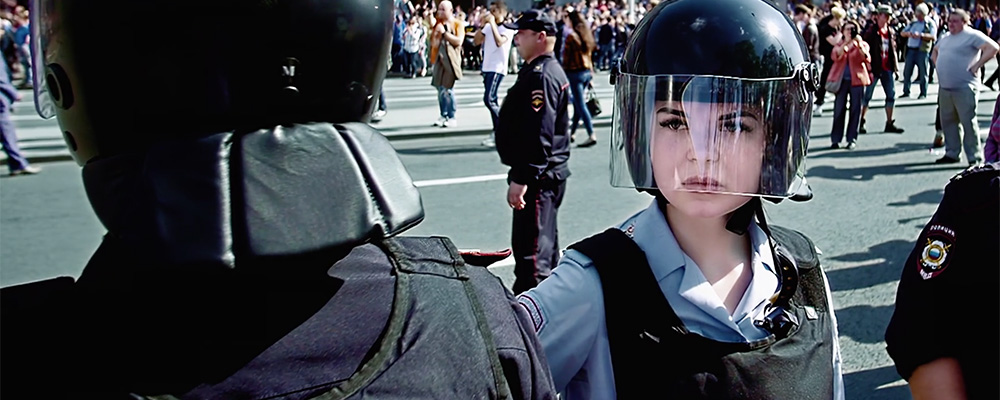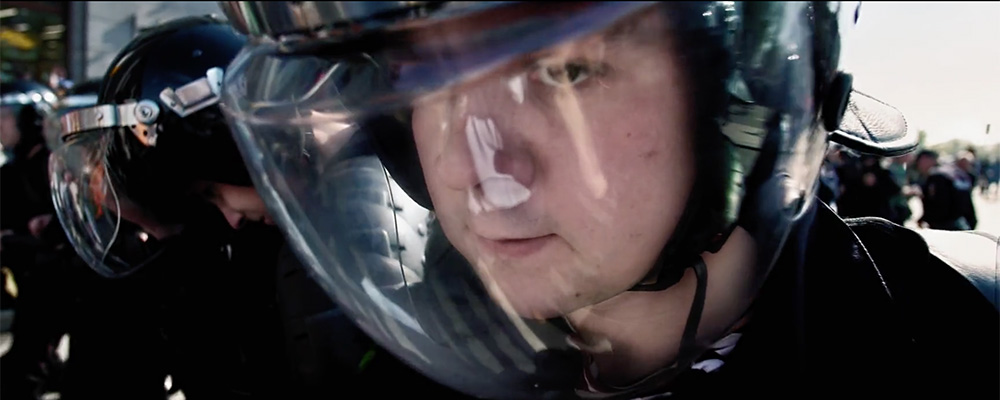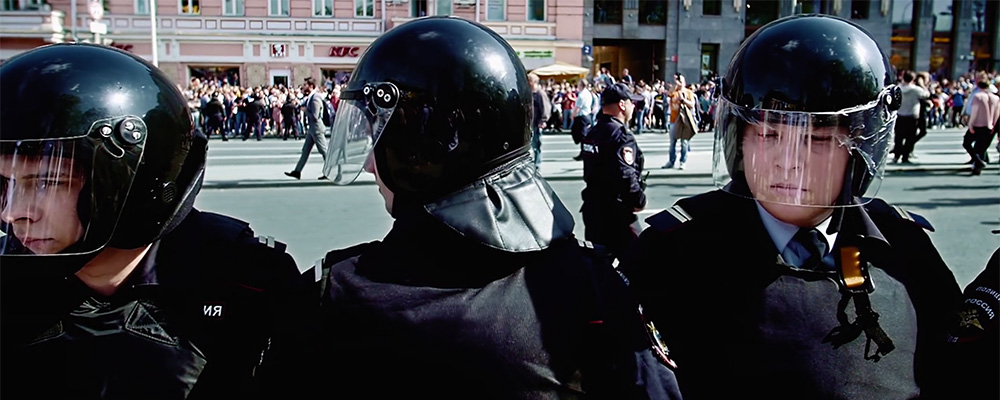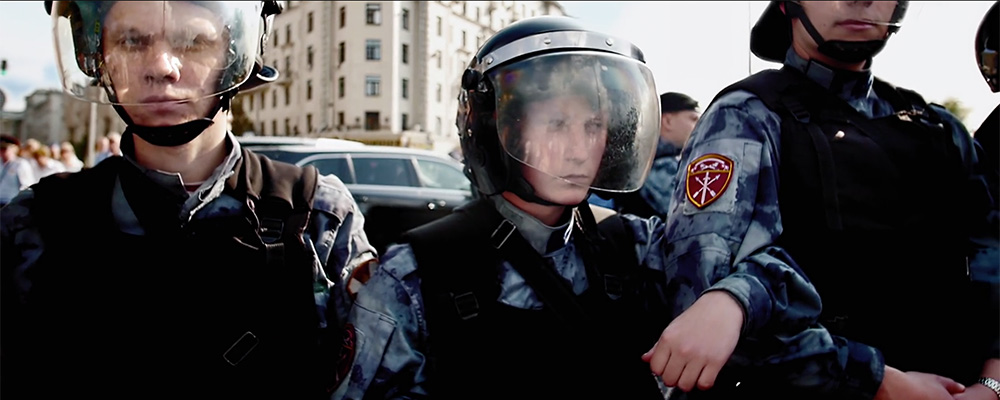
______________________________________________
FROM THE STAFF OF SF SHORTS
To Become a Fly
SF SHORTS STAFF. FEBRUARY 2022
SF SHORTS STAFF. FEBRUARY 2022
When we slow the playback of film, there is both loss and gain. Stretched too far, speech becomes arrested. Therefore, communication of content wanes as the spoken word wails, diminishing toward silence, as if in the vacuum of space. But in the slowed vision of the film, Cosmonauts, we expand insight through nuance.
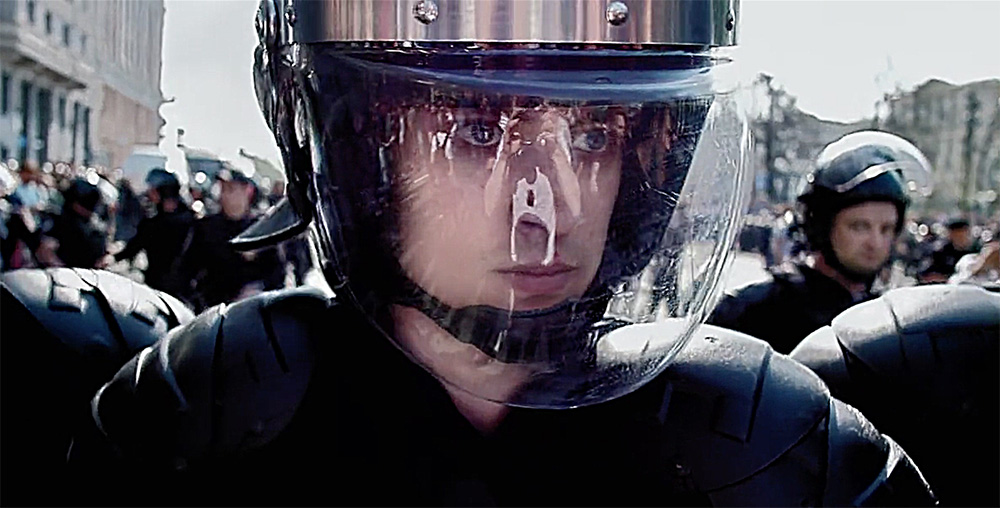
Still from the film, Cosmonauts, by Danila Gulin
In Russia, the people refer to their internal security forces as cosmonauts, an allusion to the bubble of their clear helmets. Muscovite activist filmmaker, Danila Gulin, goes further to suggest that they are like,
“astronauts from another planet, black angels, Martians who attack
the city to kidnap people and steal the sunlight.”
Nearing 40 years-old, Danila has been arrested seven times for protesting the government, although officially he has been charged ironically with impeding the rights of his fellow citizens.
The Russian constitution guarantees an individual’s rights, including free speech. However, rights can be restricted when they might be interpreted to violate the freedoms of other people, or to undermine the State, or more broadly, Russian culture.
“astronauts from another planet, black angels, Martians who attack
the city to kidnap people and steal the sunlight.”
Nearing 40 years-old, Danila has been arrested seven times for protesting the government, although officially he has been charged ironically with impeding the rights of his fellow citizens.
The Russian constitution guarantees an individual’s rights, including free speech. However, rights can be restricted when they might be interpreted to violate the freedoms of other people, or to undermine the State, or more broadly, Russian culture.

Video: Rock on the Barricades, Moscow, 1991. Photograph Left: Peter Turnley/Corbis. Photograph Right: Art Zamur/Gamma-Rapho.
CULTURE WARS : Russian authority has an evolving history of vilifying the ever-changing influence of Western fashion and music. In Stalin’s 1950’s, an adage warned that, “Today you play jazz, and tomorrow you will sell your homeland.” Russians still talk about 1991, shortly after the collapse of the Soviet Union, when the people came together to stop a military coup by former members of the Soviet leadership. Eighty-thousand citizens barricaded the country’s parliamentary building to protect their fledgling democracy from tanks. They used whatever was at hand, including rock music, to buoy the spirit of solidarity. Hard Rock and Metal carried the initial anthems for Russia’s 1990s struggling reintegration into Western democracy. But today, authority replaces the demonization of jazz with rap, banning concerts as threats to state culture.
On July 27, 2019, Danila expected to be arrested, despite his constitutional rights of free speech. In addition to the camera in his hand and the one attached to his body, he packed a kit with a spare T-shirt, socks, nuts, and extra batteries. The rally was in support of allowing independent candidates for the election of the Moscow City Duma. Danila did not have a press pass, and entered the protest, eyeing the waiting police vans as inevitable camera dollies.
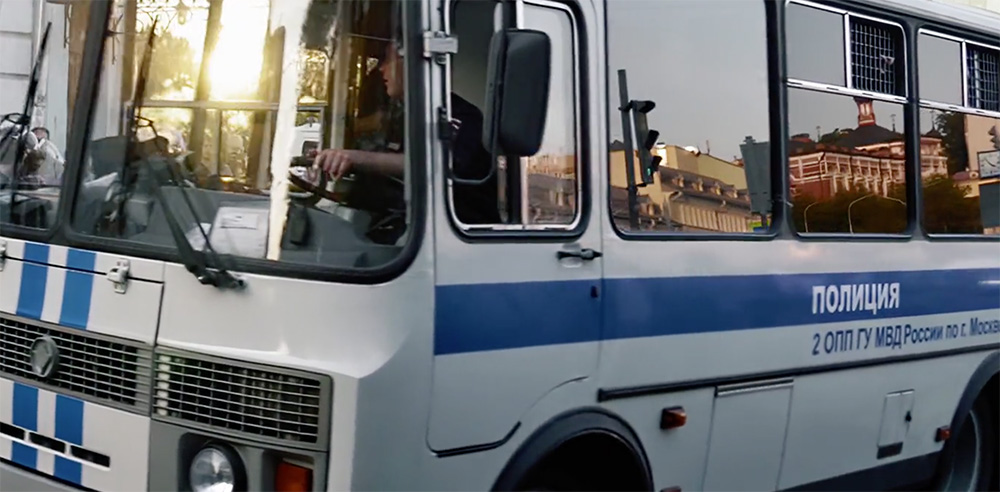
Still from the film, Cosmonauts, by Danila Gulin
Inside the rally, megaphones repeated,
“Citizens do not interfere with the passage of other citizens.”
Danila was pulled backward by an unknown force, which ripped his white polo shirt. Before he knew it, he was being carried like a teapot, from under his elbows and knees. He exclaimed repeatedly, “Everything is fine,” to assure the public servants that he was not resisting, so that they might not beat him or break his camera equipment. Eventually, he started genially whooping like a cowboy riding a horse, or a sultan displayed for the cameras. A sacrament.
“Citizens do not interfere with the passage of other citizens.”
Danila was pulled backward by an unknown force, which ripped his white polo shirt. Before he knew it, he was being carried like a teapot, from under his elbows and knees. He exclaimed repeatedly, “Everything is fine,” to assure the public servants that he was not resisting, so that they might not beat him or break his camera equipment. Eventually, he started genially whooping like a cowboy riding a horse, or a sultan displayed for the cameras. A sacrament.
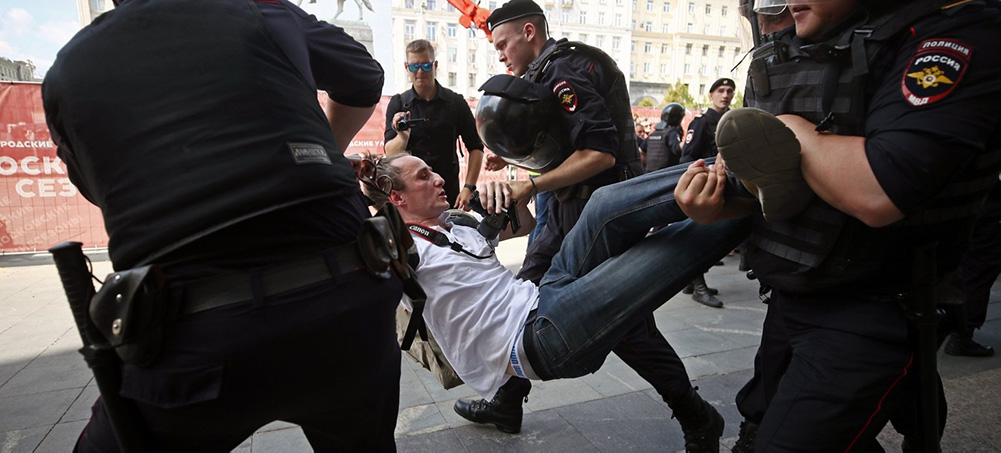
Danila was taken to a local police station, where he was held for three hours, before being released. Because it was still relatively early, he returned to the rally, and joined a proud band of protesters walking along a dark boulevard.
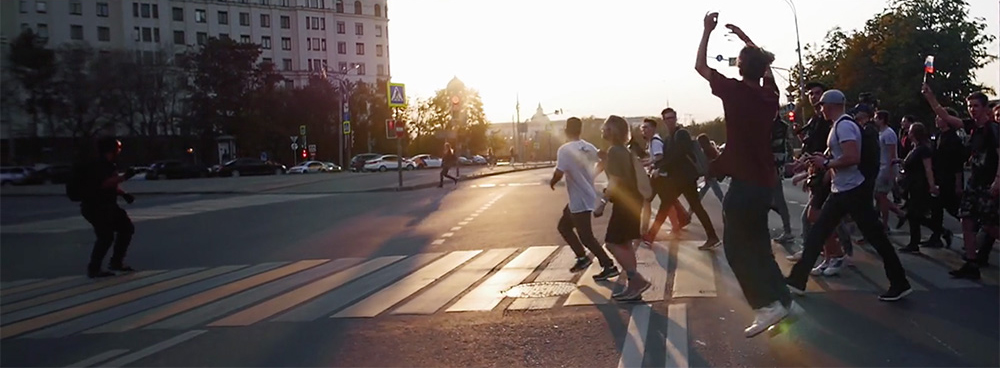
Still from the film, Cosmonauts, by Danila Gulin
He writes, “The faces of the citizens I had caught on camera earlier swam in my mind – they were so bright and beautiful. At that moment, I felt a huge surge of empathy for everyone walking nearby, the confidence that I could make friends with anyone. Then I did what I do not regret for a second, I cried out:
‘Citizens, you are all my brothers and sisters! You are the best people.
I love you all!’ In response, I heard ‘Us too!’ Approving cries, applause.”
“Then, ‘Run, dude!’ and the earth suddenly appeared very close in front of my eyes.” Danila, and everyone on that boulevard, were taken away in detention vans. This time, the charges were written more severely, so that they could be held indefinitely.
The next morning, the group of approximately 25 detainees was separated and transported to different police stations across the city, because each station could not hold more than six people. Danila was behind bars under unrelenting light with no cell phone, or shoelaces.
His prisoner’s ration consisted of “something green with squares of cardboard,” so that it was a happy surprise to receive a care package from the outside. Sausages, juice and cookies. When he asked the prison guard who had sent the package, the guard replied, “Cousin,” a moniker used by compassionate strangers because the police do not have to accept packages from non-relatives. Danila later found out that his detention had been listed online and that the care package was from a female stranger who lived near that police station. A network of civilians, from the Telegram messaging app, delivered similar packages to the detainees spread about the metropolis.
Danila spent another night in jail. On the second morning, all of the detainees from the boulevard were regathered. They were glad to see each other and shared their impressions of their “deprivation of liberty.” Each woman had been kept in isolation. At least 152 people had spent two nights at a police station.
In the police van on the way to their trial, they were offered a deal. Those without standing warrants, could plead guilty with a fine of ten-thousand rubles (approximately $135 US). Danila took the deal, partially because he had to return his rented camera equipment. That company sympathetically did not charge him late fees.
‘Citizens, you are all my brothers and sisters! You are the best people.
I love you all!’ In response, I heard ‘Us too!’ Approving cries, applause.”
“Then, ‘Run, dude!’ and the earth suddenly appeared very close in front of my eyes.” Danila, and everyone on that boulevard, were taken away in detention vans. This time, the charges were written more severely, so that they could be held indefinitely.
The next morning, the group of approximately 25 detainees was separated and transported to different police stations across the city, because each station could not hold more than six people. Danila was behind bars under unrelenting light with no cell phone, or shoelaces.
His prisoner’s ration consisted of “something green with squares of cardboard,” so that it was a happy surprise to receive a care package from the outside. Sausages, juice and cookies. When he asked the prison guard who had sent the package, the guard replied, “Cousin,” a moniker used by compassionate strangers because the police do not have to accept packages from non-relatives. Danila later found out that his detention had been listed online and that the care package was from a female stranger who lived near that police station. A network of civilians, from the Telegram messaging app, delivered similar packages to the detainees spread about the metropolis.
Danila spent another night in jail. On the second morning, all of the detainees from the boulevard were regathered. They were glad to see each other and shared their impressions of their “deprivation of liberty.” Each woman had been kept in isolation. At least 152 people had spent two nights at a police station.
In the police van on the way to their trial, they were offered a deal. Those without standing warrants, could plead guilty with a fine of ten-thousand rubles (approximately $135 US). Danila took the deal, partially because he had to return his rented camera equipment. That company sympathetically did not charge him late fees.
SECONDS OF ETERNITY
Cosmonauts was filmed in ultra-slow-motion, which was further enhanced by artificial intelligence computing. It might remind one of the video tableaus of artist, Bill Viola, who similarly saw the connection to Renaissance paintings, wherein gesture and facial expression appear as a frozen moment within a larger experience, allowing the viewer a truer insight into the psychology of individual characters.
What is the Mona Lisa thinking? What is on the mind of the cosmonaut? When watching the film, Cosmonauts, the viewer may question whether some of these security forces are merely performing a job, in spite of their individual allegiances or beliefs. In this way, Cosmonauts beautifully subverts our expectations, questioning our sympathy with the antagonist. They, who might initially be considered as villains, may obtain our compassion, in this situation that benefits no one.
Stills from the film, Cosmonauts, by Danila Gulin
When the camera-eye pierces through the glass of their helmet – and therefore through the anonymity of uniform costume – the slightest emotion becomes more readable. Certainly some of the cosmonauts seem ready for action or they perform outright abuse, but in others you can feel their shame; that they were also forced into their position, perhaps to support their families.
TO BECOME A FLY
It is difficult to catch a fly, partially because our hands push the air which a fly can detect easily relative to its size. Similar to how we can feel a storm coming.
But apparently, flies also see motion much more sensitively than we do, because they detect change more minutely than we do. This is common for species that are hunted or that hunt. The fly is common prey, the way that a hawk is a predator. Both rely on their sight for survival, more than we humans do at this point in our evolution.
Watching a film is based on a persistence of vision. Our minds blend together quickly flashing images into a virtual reality, like a flip book. After the rate about 10 consecutive images per second, we will perceive a reality of integrated motion. Most video devices project images at about 30 frames per second.
However, there is debate as to how many frames per second the human mind can discern from video or just within waking experience. The conventional average states about 60 frames per second. Scientists have determined that a fly sees at approximately 250 frames per second. That means that within each second a fly parses four-times more change in motion than we do. They see us coming before our dopey bodies get close.
It is hypothesized that when humans feel they are prey (when they fear for their safety), the fight-or-flight response releases adrenaline, which has been shown to increase pupil dilation. Our eyes are boosted for our survival. It is reasonable to suspect that our eyes and brain focus to process more frames per second in these crises. Perhaps that is why many people experience their memory of a car crash as in slow motion. They are seeing more per second than they normally would. As a reference, your fancy new cell phone may be able to record at 240 frames per second.
Slow-motion playback is one part of the genius of the film, Cosmonauts. We are given the point-of-view of being a protester at this rally. With our adrenaline pumping in fear, we experience the event heightened as if in slow motion. We become a fly evading capture or swatting. We notice more, including the subtle changes in the expression and gesture of our antagonist.
As the playback of motion is slowed, we feel the pressure of the time that is being held back. In front of a painting, we may not feel this, but if a video is playing and slows to a stop at a frozen frame, our animal instinct scans for any change in motion, knowing that in reality change is expected. It is an uneasy feeling, as the time builds up behind the frozen frame, like a dam holding back building water, or arresting the speech of citizens.
But apparently, flies also see motion much more sensitively than we do, because they detect change more minutely than we do. This is common for species that are hunted or that hunt. The fly is common prey, the way that a hawk is a predator. Both rely on their sight for survival, more than we humans do at this point in our evolution.
Watching a film is based on a persistence of vision. Our minds blend together quickly flashing images into a virtual reality, like a flip book. After the rate about 10 consecutive images per second, we will perceive a reality of integrated motion. Most video devices project images at about 30 frames per second.
However, there is debate as to how many frames per second the human mind can discern from video or just within waking experience. The conventional average states about 60 frames per second. Scientists have determined that a fly sees at approximately 250 frames per second. That means that within each second a fly parses four-times more change in motion than we do. They see us coming before our dopey bodies get close.
It is hypothesized that when humans feel they are prey (when they fear for their safety), the fight-or-flight response releases adrenaline, which has been shown to increase pupil dilation. Our eyes are boosted for our survival. It is reasonable to suspect that our eyes and brain focus to process more frames per second in these crises. Perhaps that is why many people experience their memory of a car crash as in slow motion. They are seeing more per second than they normally would. As a reference, your fancy new cell phone may be able to record at 240 frames per second.
Slow-motion playback is one part of the genius of the film, Cosmonauts. We are given the point-of-view of being a protester at this rally. With our adrenaline pumping in fear, we experience the event heightened as if in slow motion. We become a fly evading capture or swatting. We notice more, including the subtle changes in the expression and gesture of our antagonist.
As the playback of motion is slowed, we feel the pressure of the time that is being held back. In front of a painting, we may not feel this, but if a video is playing and slows to a stop at a frozen frame, our animal instinct scans for any change in motion, knowing that in reality change is expected. It is an uneasy feeling, as the time builds up behind the frozen frame, like a dam holding back building water, or arresting the speech of citizens.
 SF Shorts
SF Shorts